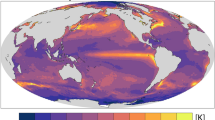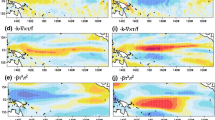Abstract
The El Niño-Southern Oscillation (ENSO) is investigated in a multicentury integration conducted with the coupled general circulation model (CGCM) ECHAM3/LSG. The quasiperiodic interannual oscillations of the simulated equatorial Pacific climate system are due to subsurface temperature anomaly propagation and a positive atmosphere-ocean feedback. The gravest internal wave modes contribute to the generation of these anomalies. The simulated ENSO has a characteristic period of 5–8 years. Due to the coarse resolution of the ocean model the ENSO amplitude is underestimated by a factor of three as compared to observations. The model ENSO is associated with the typical atmospheric teleconnection patterns. Using wavelet statistics two characteristic interdecadal modulations of the ENSO variance are identified. The origins of a 22 and 35 y ENSO modulation as well as the characteristic ENSO response to greenhouse warming simulated by our model are discussed.
Similar content being viewed by others
Author information
Authors and Affiliations
Additional information
Received: 11 August 1998 / Accepted: 25 March 1999
Rights and permissions
About this article
Cite this article
Timmermann, A., Latif, M., Grötzner, A. et al. Modes of climate variability as simulated by a coupled general circulation model. Part I: ENSO-like climate variability and its low-frequency modulation. Climate Dynamics 15, 605–618 (1999). https://doi.org/10.1007/s003820050304
Issue Date:
DOI: https://doi.org/10.1007/s003820050304




